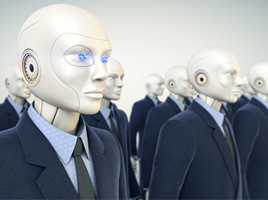Artificial intelligence (AI) is a very polarizing subject in that it’s one of the most overhyped subjects. Yet at the same time, AI has the potential to enact many profound developments in so many areas of business, and our lives.
Some people see AI taking over the world within a couple of years, while others think it isn’t even real. As usual, the truth will lie somewhere in the middle. AI brings an incredible number of possibilities, but not everything will be possible in the near future.
In this third blog, we’ll have a look at dispelling some of the myths around AI.

AI IS LIKE A PERSON: IT CAN THINK AND SOLVE ANY PROBLEM IN THE SAME WAY THAT HUMANS CAN
AI has become a marketing term that is an over-hyped generalization. There is no such thing as general intelligence in any AI yet, and perhaps we don’t need it to be either. If anything, today an AI function is more about teaching a lemur how to get food than a chimpanzee figuring it out for themselves. Still, there are many AI functions that have been created that are very useful and valuable. These functions are typically developed for a very specific purpose, such as natural language processing (NLP), image recognition, search engines, gaming, predictions or specific features in self-driving cars. Being specialized often brings higher business value than being a generalist. If you go see a doctor for a serious life-threatening condition, who would you like to see leading your treatment? A general practitioner or the renowned medical specialist in the field?
IT’S VERY EASY TO DEVELOP AN AI, AFTER ALL, IT LEARNS BY ITSELF
If only! Even machine learning, being an important part of AI, remains relatively difficult to implement. Of course, there are easier and more difficult challenges, but in general, to implement algorithms that work well for your enterprise application or problem can be quite tedious.
Often, the actual machine learning algorithms are easy enough to understand. The challenge is in selecting the right algorithm for the problem and presenting the problem to the algorithm in the correct way. This requires a detailed knowledge of the problem as well as a relatively deep understanding of the capabilities and constraints of the available algorithms and models. Still, this is a problem that’s relatively common throughout computer science.
Complicating matters further is that machine learning needs the correct amount of training so that the model remains general enough to be useful for new problems. Troubleshooting, if it doesn’t work as expected, can be time-consuming since the models built by neural networks, for instance, can be very complex and difficult to understand.
BIG DATA IS EVERYWHERE
Yes! There is a lot of data out there. A single flight of a Boeing 787 generates 500 GB of data from the various sensors and instruments it carries. At any one time there are more than 170 Boeing 787s in the air, so that’s a lot of data. But often with implementing machine learning algorithms, the question is “do we have the right data?” and also “can we make useful information out of all this data?”
An example that we worked on in IFS Labs is Sentiment Analysis. According to Wikipedia, sentiment analysis (or opinion mining) refers to the use of natural language processing, text analysis and computational linguistics to identify and extract subjective information in source materials.
For example, can you use sentiment analysis on social media to improve the accuracy of predicted future demand, and there is a lot of social media data available, e.g. Twitter, Facebook, etc. In practice, it depends a lot on your actual use-case. If you would like to understand the sentiment on the newest iPhone, you can probably find sufficient data. But if you would like to understand the sentiment on people’s perception of the smart meter installations in a country, it’s already difficult to find sufficient, specific enough data to get meaningful results.
As with any type of analysis, the amount and reliability of underlying datasets are critical to the success of the machine learning and it just isn’t always there.
ALL OF OUR JOBS WILL BE REPLACED BY ROBOTS
So far in history, each and every technology revolution has created more jobs than it destroyed. Whether we look at the industrial revolution or the rise of the internet, in the end, more people had a job than before, and often better-paid ones as they were more productive. So, I expect that the benefits of AI will outweigh the disadvantages, especially if people are helped and encouraged to learn the new skills they will need to work alongside intelligent systems.
Also, technological developments often take longer than we initially predict and machines with general intelligence are probably many decades away from being developed if they are possible at all. Therefore, a more likely scenario is that humans and AI will work together, collaborating and enforcing each rather than the pessimistic, but headline-generating doom scenarios.
And although AI technology will provide us the opportunity to augment and partially replace human work while creating new jobs, those new jobs will require higher skilled people. Or, as Gartner is predicting, “already in 2020, AI becomes a positive net job motivator, creating 2.3 million jobs while only eliminating 1.8 million jobs.”
THERE’S MORE
This is not everything of course. There are many more statements and quotes out there on AI worth looking into and perhaps most of them can be considered myth as well. As with most things, finding a balance between being optimistic and pessimistic works well for you in AI. Don’t believe everything that’s said, but invest in those opportunities that are actually feasible as they have the potential to change the way we do business.



